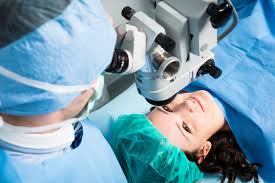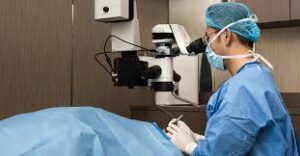If you’ve been a cataract surgery patient for some time, you might be thinking about how to get the best cataract surgery. What are your options for technology? Would it make a difference if the surgery was done in an eye clinic or on the other side of the world? Let’s find out more about which technology is best for your vision.
Contents
- 1 What Is Cataract Surgery?
- 2 How Does Best Cataract Surgery Work?
- 3 What is the Best Technology for Cataract Surgery?
- 4 Which is Better Laser or Regular Cataract Surgery?
- 5 What Is The Safest Surgery For Cataracts?
- 6 Do Laser Cataract Surgery Heal Faster?
- 7 What are the Benefits of the Latest Technology for Cataract Surgery?
- 8 Conclusion
What Is Cataract Surgery?

Cataract surgery is a procedure that removes the clouding or opacification of the eye’s lens. It is performed either as a complete cataract removal, in which all the cataracts are removed and the eye is replaced with an artificial lens or as a cataract replacement, in which only a portion of the cataracts is removed and an artificial lens is inserted into the eye.
How Does Best Cataract Surgery Work?
For most patients, cataract surgery is an outpatient procedure that takes less than an hour.
To start surgery, your doctor will first place drops in your eye to dilate your pupil. You’ll receive local anesthetics to make you feel numb and sleepy. If you weren’t given a sedative beforehand, you may stay awake but groggy during the operation.
Laser cataract surgery is usually a pretty simple procedure.
- First, the cloudy lens is removed and replaced with a clear artificial one. In some cases, however, the doctor may remove your cataract without implanting an artificial lens.
- Using an ultrasound probe to break up the lens for removal.
Your surgeon then uses the probe, which transmits ultrasound waves, to break up (emulsify) the cataract. The very back of your lens (the lens capsule) is left intact to serve as a place for the artificial lens to rest. In most cases of cataract surgery, improvements in vision will be noticed within a few days. Reduced eyesight can be expected as your eye heals and adjusts. - After having cataract surgery, colors may appear more vibrant and brilliant. This is because you are now looking through a clear lens that wasn’t there before. Usually, the cataract is yellow- or brown-tinted and causes colors to look less vibrant in your field of vision.
- You’ll usually see your eye doctor the day after surgery, in about a week, and then again one-month post-surgery for follow-up.
- After surgery, it’s normal to feel itching and mild discomfort in your eye. Don’t push or rub on your eye – that can cause more discomfort.
- Your doctor may ask you to wear an eye patch or protective shield before and after your surgery. The eyepatch should be worn the day of surgery, as well as for a few days afterward when you sleep. Eye drops or other prescriptions may be given to prevent infection, reduce inflammation, and control eye pressure. Sometimes these medications can be injected into the eye at the time of surgery.
After a few days, the majority of your symptoms should settle down. Usually, complete healing occurs after eight weeks.
It’s no surprise that this is one of the most common procedures performed while there are many different types of cataract surgery technology available, the safest and best technology work is still LASIK.
During this, the doctor first creates a flap in your upper eyelid by making an incision just above your pupil. The flap is then lifted and placed over the front part of your eye so that the laser can be used to remove unwanted material from your eye’s surface. The Lasik surgeon then sculpts your new surface by adjusting tiny blades to create precise contours. After Lasik surgery is complete, you will have temporary vision correction medication to take care of any post-operative discomfort. Laser-assisted subconjunctival keratomileusis (LASIK) is considered to be the safest option.
It does not require you to have any stitches or take any medication after surgery. In addition, LASIK has a very low complication rate – only 1 out of every 1,000 patients experiences a postoperative complication. And because LASIK does not involve making an incision in your eye, you can continue wearing your glasses after surgery.
Different Types Of Cataract Surgery
There are several types of technology available.
Lasik Surgery, Surgical Spectacle Repair (SURGERY), and Intraocular Lens Implant (IOL).
In general, Lasik surgery is the most popular form of cataract surgery it has been practiced for more than 20 years and accounts for approximately two-thirds of all cataract surgeries performed. Lasik Surgery uses a special type of laser to perform its operation on the surface of the eye.
Surgical spectacles repair (SUR GERY) is a less invasive alternative to Lasik surgery that uses an old-fashioned pair of eyeglasses to correct vision. During SURGERY, the doctor makes an incision in the upper eyelid and removes the old glasses. He then reshapes and repairs the eye’s surface using a thin tube called a telescope. Intraocular lens implant (IOL) is another less invasive type of surgery that uses an artificial lens to replace the clouded or cataracted part of the eye’s lens. IOLs are custom-made for each patient and are inserted into the eye through a small surgical incision.
What is the Best Technology for Cataract Surgery?

Laser-assisted is the latest and most advanced method. Many ophthalmologists prefer laser over traditional cataract surgery as a pre-treatment to “soften” their patients’ lenses before surgery. One of the biggest advantages of laser-assisted is that it eliminates the need for general anesthesia. This makes the surgery much more comfortable for patients and allows them to RECOVER faster after surgery. In addition, laser-assisted is performed with smaller incisions than traditional cataract surgery, which results in a shorter recovery time.
Phacoemulsification, a type of ultrasound, is the most used method to remove the cataract. After removing it, there will be an artificial lens to replace it. An IOL is a clear, plastic lens that does not need care and becomes a permanent part of your eye.
Femtosecond laser-assisted is an innovation in cataract surgery that has increased safety as well as accuracy. With its bladeless design, it automates the traditionally complicated steps of the surgery, meaning patients will spend less time recovering.
Another advantage of laser-assisted is that it can be performed on most types of lenses. This makes it an ideal option for patients who have difficult-to-repair lens implants or who have previously performed using other methods.
Which is Better Laser or Regular Cataract Surgery?
Laser cataract surgery is just as successful and safe as regular cataract surgery. On average, the evidence suggests that patients who have laser-assisted cataract surgery tend to see about as well as patients who have traditional cataract surgery. There’s not any significant difference in outcomes between both options.
What Is The Safest Surgery For Cataracts?
Patients undergoing laser this surgery can expect fewer complications and require less recovery time than those going under the knife with a traditional procedure. Both types of surgeries are safe, but for many patients, lasers may be slightly safer because of these benefits.
Laser cataract surgery is not without risk, but it often results in fewer complications and a shorter recovery time. For example, laser surgery does not require general anesthesia, so there is less risk of complications from an adverse reaction to the anesthesia. In addition, laser does not involve any cutting or bruising of the eye, which can lead to permanent vision loss in some cases.
Cataract surgery is a serious procedure and should not be taken lightly. If you are considering, be sure to speak with your doctor about the risks and benefits of both types of procedures.
Do Laser Cataract Surgery Heal Faster?
Ultrasound contains energy that can damage the eye if it is applied for a long period of time. However, lasers use so much less energy to break up the cataract than ultrasound does that patients may experience less corneal swelling. “If we use less energy and have fewer corneal swellings, the eye can heal faster.”
Femto laser cataract surgery is a highly precise, blade-free surgery that’s completely automated. The laser incisions are self-sealing and are much more accurate than that other surgeries. It’s compatible with a wide variety of intraocular lenses and minimizes pain while recovering quickly. As an added measure, it also reduces the chances of human error drastically.
Laser cataract surgery is more expensive than traditional cataract surgery, but it may heal faster and result in fewer complications.
If you are considering laser cataract surgery, be sure to discuss your options with your doctor.
What are the Benefits of the Latest Technology for Cataract Surgery?
LASIK is a type of surgical procedure that uses lasers to remove your eye’s lens. The laser cuts through the cornea, causing it to heal rapidly and without complication. This is why LASIK is considered the safest and best technology for it has a very low risk of complications and produces excellent results.
It has been around for centuries and has remained a popular procedure because of the many benefits it offers. Modern technology is available to doctors that allows them to perform more precise operations and remove fewer cataracts with each procedure. Here are some of the major benefits of using this latest technology:
Reduced Eye Surgery Time
The use of modern technology allows doctors to perform more precise operations that result in shorter times. In some cases, surgery can be completed in as little as 20 minutes, which is much faster than traditional surgeries that can take up to an hour or more.
Better Cataract Removal Rates
With modern technology, doctors are able to remove more cataracts with each procedure. This results in fewer complications and a quicker return to normal life for patients.
Improved Vision
Cataracts can cause significant vision loss, and with modern cataract surgery technology, patients often see better outcomes than those who undergo traditional surgeries. In some cases, patients may regain near-normal vision after undergoing cataract surgery using this technology.
If you’re considering laser-assisted subconjunctival keratomileusis for your cataract treatment, make sure to speak with an eye doctor about all of your options. There are many safe and effective technologies available – so don’t hesitate to choose the one that’s right one for you.
Conclusion
Cataract surgery is one of the most common procedures performed. In this article, we will discuss the different types of cataract surgery technology and which might be best for you. We encourage you to research all your options before making a decision, as there are many benefits to choosing the right type of technology for your individual needs.
Cataract surgery is a safe and painless procedure. At MantraCare we have a team of experienced eye surgeons, who will be happy to answer any questions on cataract surgery. Call us at +91-9711116605 for any inquiries.
